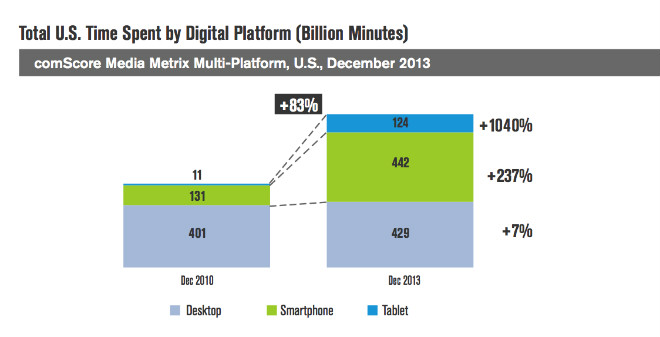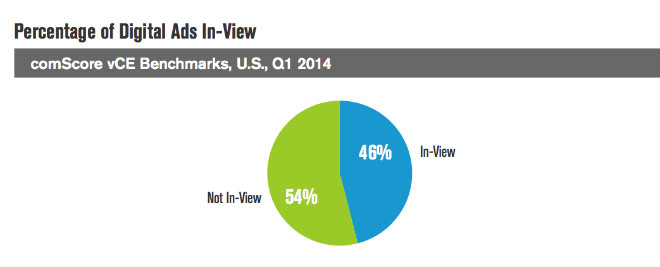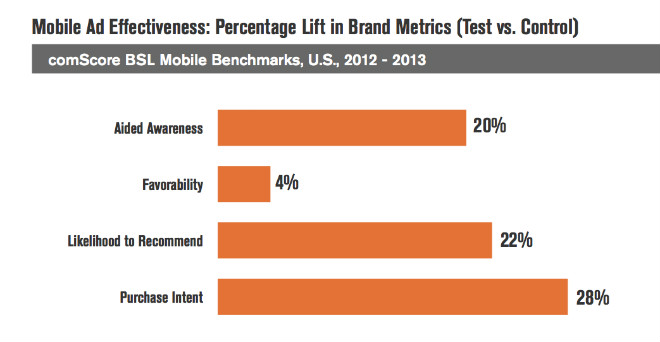Bringing the Digital Future into Focus

In 2013, our industry was rocked – not by advances in technology, but rather by changes observed in digital consumer behavior. An explosion of new platforms and devices is enabling a significant uptick in content consumption, which presents a vast opportunity for marketers who are ready and able to navigate the changing digital media landscape.
A new comScore report, 2014 U.S. Digital Future in Focus, reveals four fundamental and universal shifts seen over the past year: platform, content, demographics, and marketing. Understanding each of these factors – or rather accurately predicting how, where and when your customers are ready to engage – will have a huge impact on the success of your marketing.
At the close of 2013, 56 percent of digital media users in the U.S. made up the “multi-platform majority” – i.e., people who use both mobile and desktop devices. Having passed this majority milestone, assume that from now on your customers will expect to engage with your brand via multiple platforms. comScore writes: “There are advantages and disadvantages to each device, and consumers are using all of them to perform their tasks and activities, depending on what they are doing, where they are, and which device is most convenient.”
In fact, the convenience of on-the-go access has led Americans to spend more time online than ever before. In the past three years, time spent online has grown by 83 percent, while desktop online usage alone has only grown by 7 percent. Yes, we can assume that without mobile technology perhaps desktop browsing would have seen a greater increase. And yes, mobile technology is definitely poaching the amount of time consumers spend browsing on a desktop computer. Yet these digital platforms cannot be compared apples-to-apples; smartphones enable browsing where it previously did not exist, creating a new opportunity for growing our time spent online.
…And increasing the amount of face time we have with online advertisements, content, and media.
Digital has proven itself as a medium able to reach targeted audiences at scale while delivering measurable lifts in brand and sales metrics. As a result, digital advertising attracts a significant amount of brand dollars. Yet the efficiency and performance of digital ad delivery continues to cause concern among advertisers. In fact, a recent comScore study indicates that only 46 percent of ad impressions had the opportunity to be seen by a consumer. The other 54 percent are void for one of several reasons: if a user leaves the page before 1-second passes, if the ad loads outside the browser window, or if “viewed” by non-human traffic (NHT).
Marketers are also concerned about delivery to their target audience. It’s not uncommon for an ad to be seen by the “wrong” person (i.e., someone outside of the meticulously defined target audience), owing to outdated demographics, inaccurate registration data, poor assumptions, or the fact that more than 60 percent of computers are shared.
These concerns notwithstanding, marketers are indeed seeing monetization through digital media. Mobile advertising, however, is another story. A comScore study shows how mobile ads work very well in driving bottom-of- the-funnel brand metrics (pictured), but have yet to monetize in a significant way for the majority of media companies.
One solution to the mobile ad monetization challenge is native advertising, like Twitter’s Promoted Tweets, Linkedin’s Sponsored Updates, and Pinterest’s Promoted Pins. These ad units appear in the social sites’ primary content streams and are native to the user experience, regardless of which device your audience is using. It comes as no surprise, then, that social sites are not facing the same challenges in driving revenue through mobile advertising:
- Facebook: mobile advertising accounts for 53% of total ad revenue
- Twitter: mobile advertising accounts for 75% of total ad revenue
The ultimate solution for advertisers is to develop integrated cross-platform campaigns that span digital media (desktop, mobile, tablet) and TV. As advertisers discover which marketing mix combinations are most effective in improving sell-through rates and CPMs, it’s expected that mobile advertising will become an invaluable campaign component for maximizing brand awareness and increasing sales. To that end, media companies are busy rethinking the content experience to identify which formats are most engaging, when and where.
In 2013, apps accounted for 85% of internet time spent on phones. Does that mean consumers are spending more time playing Candy Crush than reading your content? Probably. But it also means that more and more mobile users are engaging with companies via branded apps rather than through their mobile sites. Think of mobile banking apps, food delivery apps, and online shopping apps – like those from Bank of America, Domino’s, Starbucks, Amazon, and others. Apps present an optimized user experience (UX), and are quickly becoming the primary channel for engaging with brands on a mobile device.
But what can it mean for mobile advertising if consumers are only spending 15% of their time actually browsing the internet? The answer is one you might expect: mobile in-app ads are predicted to surpass PC online display advertising revenues by 2017. And Google, still the country’s unchallenged search leader, is working to enable more linking directly to apps – which are typically walled off from traditional search indexing.
While marketers cannot always predict the next wave of technology, we can anticipate that digital consumer behavior will continue to reveal new insights. This, perhaps, is a defining feature of the digital future, where disruptive market changes are to be expected – and welcomed!
All statistics in this blog post were sourced from 2014 U.S. Digital Future in Focus, a report produced by comScore.


